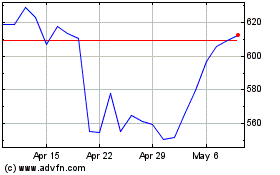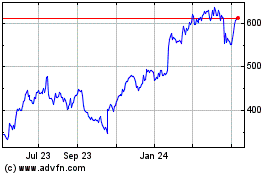Tech Bulls Brush Off Price Fears -- WSJ
August 20 2018 - 3:02AM
Dow Jones News
Stocks' high multiples fuel investor anxiety, but sector fans
say they overstate risks
By Michael Wursthorn
This article is being republished as part of our daily
reproduction of WSJ.com articles that also appeared in the U.S.
print edition of The Wall Street Journal (August 20, 2018).
The buoyant performance of U.S. tech stocks is driving some fund
managers and others to dismiss longstanding valuation concerns as
short-sighted.
While shares of companies including Amazon.com Inc., Netflix
Inc. and Salesforce.com Inc. have surged this year to
price/earnings ratios that are several times the market's longtime
average, many fans of these investments contend that such metrics
can overstate risks. They say they prefer a broader assessment of
financial and strategic progress, arguing that this view can be
more germane to those expecting to hold the shares for a longer
period.
"I don't talk about multiples. That's where the conversation
stops," Jonathan Curtis, a portfolio manager at Franklin
Templeton's Franklin Equity Group, says of discussions with others
about tech companies. "I tell them, 'Help me understand what this
business looks like at maturity.'"
The question of how to value popular technology shares is coming
into sharp focus because major indexes are on track to set a new
intraday record for the longest U.S. bull market in stocks
Wednesday. The nine-year advance recently has been led by furious,
sustained rallies in Amazon, Apple Inc. and Google parent Alphabet
Inc., among others.
Skeptics say high valuations and a lack of "breadth" -- that is,
outsize gains concentrated in a small number of popular stocks --
leave the broader market vulnerable to a pullback. An analysis of
data going back to 1964 shows that higher multiples have tended to
be followed by weaker returns over 10-year stretches, according to
Credit Suisse Group AG.
But some investors who say they see these investments as
long-term holdings are digging in their heels. In their view, the
scrutiny of valuations risks overlooking the future value of
current investment spending at firms with substantial edges in key
markets, such as Amazon's expansion of its cloud-computing business
and other firms' acquisition of valuable subscribers in fields they
lead.
Believers in this approach may have some market math on their
side: The valuation of the average stock in the S&P 500 is now
in the 97th percentile of historical levels, according to Goldman
Sachs Group Inc., which analyzed 40 years of data. While that is
down from the 99th percentile at one point last year, it shows that
the concerns about valuation could be applied to a vast swath of
the market, not just tech. Even consumer-staples firms, seen as
defensive plays expected to do well in an economic slowdown, appear
overpriced to many investors.
Of course, few question that higher multiples raise the risk of
a near-term share-price decline in response to any given negative
development, be it an earnings shortfall or a shock in a far-off
market that hits sentiment. Investors in tech favorites Netflix and
Facebook were reminded of this last month in the wake of sharp
stock declines that followed profit-report disappointments.
"Valuations matter a lot more as you extend the time horizon,"
said John Prichard, president of Knightsbridge Asset Management,
who expects rising interest rates to lead to a shakeout at some
point that "will depress high-P/E stocks."
But the rise of interest rates this year has been slow and tech
remains popular, with fund managers most heavily tilted toward tech
of all 11 major S&P 500 industry sectors. The average portfolio
manager holds about 1.2% of its fund in tech and internet stocks,
according to a Bank of America Merrill Lynch report last month.
In part, that is because many of the largest tech firms have
carried outsize multiples throughout a run to record highs, and
have shown impressive earnings gains during recent years that have
brought down their price/earnings ratios even as shares notch large
gains.
Take Amazon, up more than 60% this year and trading at a lofty
85 times future earnings: Improving earnings in recent quarters
have driven the firm's price/earnings ratio down from its average
level over the past three years of around 115 times, according to
FactSet. In comparison, the S&P 500 trades at about 16 times
earnings expected over the next 12 months.
Less than five years ago, Facebook was trading at more than 50
times forward earnings as it outspent rivals to dominate social
media's advertising landscape. Increased profits have brought its
valuation down to 23 times today, even after the record
market-value decline last month.
Salesforce is up more than 40% this year, yet fans contend the
market is undervaluing its capacity to win long-term customers and
penalizing the software firm for up-front marketing and sales
costs.
"It's very easy to analyze this year's costs and say, Look at
all this spend, it's unprofitable," said Matt Sabel, a portfolio
manager for MFS Investments.
Write to Michael Wursthorn at Michael.Wursthorn@wsj.com
(END) Dow Jones Newswires
August 20, 2018 02:47 ET (06:47 GMT)
Copyright (c) 2018 Dow Jones & Company, Inc.
Netflix (NASDAQ:NFLX)
Historical Stock Chart
From Mar 2024 to Apr 2024

Netflix (NASDAQ:NFLX)
Historical Stock Chart
From Apr 2023 to Apr 2024
